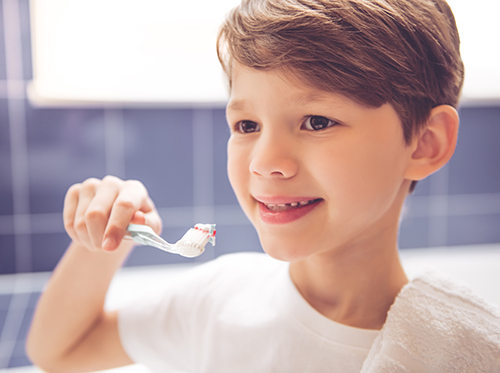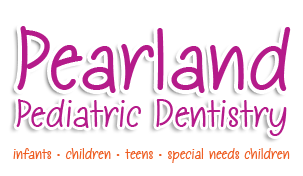August 9th, 2023

One of the most frequent questions that Dr. Pamela Clark and our team hear is about what kinds of snacks are best for a child’s dental health. Sugary snacks are inevitable sometimes, but it’s vital for you as a parent to monitor how frequently your child is eating the kinds of snacks that may give him or her a cavity or two down the line.
Unsurprisingly, the best snacks are healthy ones, though they may not always be the most appealing to your little ones. The good news is that healthy doesn’t mean you have to compromise on taste. Once your kids give these tasty snacks a go, they might become open to all things healthy!
- Fresh veggies and hummus
- Apple wedges with peanut butter
- Low-fat yogurt with berries
- Cubes of cheese and crackers
- Hard-boiled eggs with a little bit of salt and pepper
- Celery sticks with cream cheese and sunflower seeds
- A homemade milkshake with low-fat milk (or almond milk), the fruit of their choice, chia seeds, and cinnamon
- Lean proteins such as chicken breast, fish, and turkey
These snacks aren’t high in sugar but they contain all the nutrients your children need to have the necessary energy throughout the day.
This is only a sample of all the great, healthy snacks out there for your kids. For more ideas, ask us the next time you visit our Pearland, TX office. It’s never too early to create healthy habits; they’re not only good for oral health, but overall health too. That’s a win-win, if you ask us.
August 9th, 2023

Here is some surprising yet worthwhile advice you might be hearing for the first time: Brushing can be incredibly bad for your child’s teeth if done right after eating certain foods.
Enamel is an extremely hard mineral on the exterior of each tooth. It’s actually the hardest substance in the human body: It’s even stronger than bones! Its only weakness is that acids in the food we eat can easily destroy enamel.
Healthy teeth thrive in an environment that has the proper pH balance. That ensures the mouth doesn’t start the process of demineralization—the process when alkaline turns into acid, which attacks and softens the enamel on the surface of your child’s teeth. Pores and fissures form, and that’s when the harmful bacteria go to work.
A mouth’s pH level fluctuates depending on what is eaten throughout the day. Examples of the most common highly acidic foods include citrus fruits, soda, and sugary foods. Highly acidic foods tip the balance of pH in the mouth from a healthy alkaline to a dangerous acid.
Can brushing your child’s teeth immediately after a meal lead to even more damage? The answer is yes!
Eating highly acidic foods causes your child’s teeth to be more susceptible. If your child brushes when the teeth have been weakened by acids, even more destruction can happen to the enamel. Your child’s toothbrush bristles will actually wear away some of the enamel. So it’s healthier for your child to wait at least an hour after eating or snacking to brush.
Good preventive measures to take instead of brushing after your child eats include:
- Rinsing or drinking water
- Chewing sugarless gum
- Consuming dairy or non-acidic foods to conclude a meal
These practices help produce saliva, which in turn restores a healthy pH level in your child’s mouth and coats the teeth with minerals they need.
Once your child’s mouth is restored to a healthy pH level, he or she may brush normally. Keep in mind that acidic foods can weaken the enamel on the teeth and take the right measures to prevent spiking pH levels.
Still have questions? Call our Pearland, TX office and schedule an appointment for your child with Dr. Pamela Clark.
August 2nd, 2023

Fluoride is a mineral that plays an essential role in oral health. In fact, the significant reduction in American tooth decay in recent decades can be attributed to a greater availability of fluoride in public water supplies, toothpaste, and other resources. When it comes in contact with the teeth, fluoride helps protect the enamel from acid and plaque bacteria. In some cases, it can even reverse tooth decay in its earliest stages.
Despite the benefits of fluoride, tooth decay is still common, especially among teenagers. The Centers for Disease Control reports that cavities can be found in more than half of young teens and two-thirds of older teens over age 16. Many of those teens are deficient in fluoride, either due to a lack of public water fluoridation or the use of bottled water. So how can parents ensure their teens are getting the fluoride they need to facilitate strong, healthy teeth?
Monitor Fluoride Exposure
Dr. Pamela Clark and our team at Pearland Pediatric Dentistry recommend you start by measuring your teen’s fluoride exposure. Make sure you purchase fluoridated toothpaste for your household, and find out if your tap water is fluoridated. If your teen primarily consumes bottled water, examine the bottle to determine whether fluoride has been added. The majority of bottled waters are not supplemented with fluoride, but those that are will be clearly labeled.
Fluoride Supplementation
Dr. Pamela Clark may recommend topical fluoride treatments at routine dental exams. These treatments are painless for your teen and may help establish stronger enamel that is more resistant to plaque and tooth decay. If you have a public water supply that is non-fluoridated, we may recommend fluoride supplementation between visits. These can be administered as drops, tablets, or vitamins.
Keep in mind that fluoride is most important for children and teens under the age of 16. Be proactive about your teen’s oral health by speaking with us about your family’s fluoride needs at your next dental visit.
For more information about fluoride, or to schedule an appointment with Dr. Pamela Clark, please give us a call at our convenient Pearland, TX office!
August 2nd, 2023

The wisdom teeth are the last of the permanent molars to emerge from the gums. This can occur as early as age 17 or as late as 21. Though some teens and young adults experience a completely normal tooth eruption with ideally aligned molars that pose no health threat, this is not the case for everyone.
According to the American Association of Oral and Maxillofacial Surgeons (AAOMS), wisdom teeth must meet specific criteria to avoid a required extraction. These guidelines include:
- Completely erupted and non-impacted
- Completely functional
- Painless
- Free of decay
- Disease-free
- Capable of being properly cleaned
If one or more of your child’s wisdom teeth do not meet these conditions, we recommend scheduling an appointment with Dr. Pamela Clark; an extraction may be necessary.
Impacted wisdom teeth
One of the most common reasons for extracting a wisdom tooth is due to impaction. An impacted wisdom tooth is one that has not erupted and will not fully erupt from the gums. Usually this occurs because there is not enough room for the tooth to emerge. Impaction can be painful and can also lead to infection if left untreated. According to the AAOMS, roughly 90 percent of the teen and adult population has at least one impacted tooth. Extracting an impacted wisdom tooth early can help prevent future complications, such as periodontal disease, infections, and damage to neighboring teeth.
Extracting fully erupted wisdom teeth
Even if your child’s wisdom teeth are fully erupted, Dr. Pamela Clark and our team at Pearland Pediatric Dentistry may recommend removing them as a preventive measure. Fully-erupted third molars often interfere with a healthy bite. This can lead to problems with tooth and jaw alignment and may also contribute to the development of headaches. Your child’s wisdom teeth may also be more prone to tooth decay and gum disease, because their location in the back of the mouth makes them more difficult to reach for brushing and flossing.
To learn more about wisdom teeth, or to schedule an appointment with Dr. Pamela Clark, please give us a call at our convenient Pearland, TX office!








